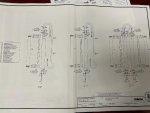OurTown
Well-known member
We are upgrading our RO system from a double membrane 4,400 GPD to a triple membrane 6,600 GPD. It is a 21 year old Propak with a 3 HP pump from Huron Valley Sales. I talked to Fred there and he said the pump is large enough for the upgrade. The feed, reject, and product water rails are all triple tapped, so I thought running a third membrane in parallel like the others would be convenient. Fred suggested a different way that they plumb their 6,600 GPD units.
Let's assume the original membranes to be #1 and #2 and call the new one #3.
Leave #1 the way it is plumbed.
On #2 keep the feed and product water hoses intact.
Run the reject hose from #2 to the feed inlet on #3.
Run the reject from #3 to the reject rail.
Remove the plug from the bottom of #2 and run the product water hose from #3 to it.
He said this way was better than just running the new one in parallel but I don't remember if he said why. Maybe it puts out lower overall reject water to product water ratio?
Wouldn't the secondary membrane clog or wear out faster because it is being fed with water that has about twice the TDS? Why run the #3 product water back through the center of the #2 membrane? Does that balance pressure?
Let's assume the original membranes to be #1 and #2 and call the new one #3.
Leave #1 the way it is plumbed.
On #2 keep the feed and product water hoses intact.
Run the reject hose from #2 to the feed inlet on #3.
Run the reject from #3 to the reject rail.
Remove the plug from the bottom of #2 and run the product water hose from #3 to it.
He said this way was better than just running the new one in parallel but I don't remember if he said why. Maybe it puts out lower overall reject water to product water ratio?
Wouldn't the secondary membrane clog or wear out faster because it is being fed with water that has about twice the TDS? Why run the #3 product water back through the center of the #2 membrane? Does that balance pressure?






